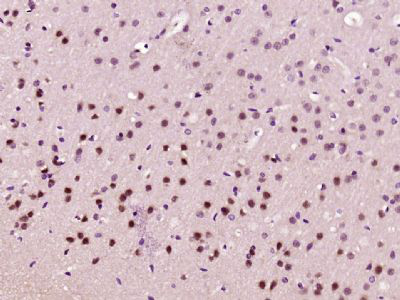产品货号 : mlR5482
英文名称 : phospho-MEF2C (Thr20)
中文名称 : 磷酸化肌细胞增强因子2C抗体
别 名 : MEF2C(phospho Thr20); MEF2C(phospho T20); MADS box transcription enhancer factor 2 polypeptide C (myocyte enhancer factor 2C); Myocyte enhancer factor 2C; Myocyte specific enhancer factor 2C; Similar to MADS box transcription enhancer factor 2 polypeptide C; MEF2C_HUMAN.
产品类型 : 磷酸化抗体
研究领域 : 心血管 细胞生物 免疫学 染色质和核信号 神经生物学 信号转导 转录调节因子
抗体来源 : Rabbit
克隆类型 : Polyclonal
交叉反应 : Human, Mouse, Rat, Chicken, Dog, Pig, Cow, Horse, Rabbit,
产品应用 : ELISA=1:500-1000 IHC-P=1:400-800 IHC-F=1:400-800 IF=1:100-500 (石蜡切片需做抗原修复)
not yet tested in other applications.
optimal dilutions/concentrations should be determined by the end user.
分 子 量 : 51kDa
细胞定位 : 细胞核
性 状 : Lyophilized or Liquid
浓 度 : 1mg/ml
免 疫 原 : KLH conjugated Synthesised phosphopeptide derived from human MEF2C around the phosphorylation site of Thr20:QV(p-T)FT
亚 型 : IgG
纯化方法 : affinity purified by Protein A
储 存 液 : 0.01M TBS(pH7.4) with 1% BSA, 0.03% Proclin300 and 50% Glycerol.
保存条件 : Store at -20 °C for one year. Avoid repeated freeze/thaw cycles. The lyophilized antibody is stable at room temperature for at least one month and for greater than a year when kept at -20°C. When reconstituted in sterile pH 7.4 0.01M PBS or diluent of antibody the antibody is stable for at least two weeks at 2-4 °C.
PubMed : PubMed
产品介绍background:
MEF2C is a transcription activator which binds specifically to the MEF2 element present in the regulatory regions of many muscle-specific genes. This protein controls cardiac morphogenesis and myogenesis, and is also involved in vascular development. It may also be involved in neurogenesis and in the development of cortical architecture.
Function:
Transcription activator which binds specifically to the MEF2 element present in the regulatory regions of many muscle-specific genes. Controls cardiac morphogenesis and myogenesis, and is also involved in vascular development. Plays an essential role in hippocampal-dependent learning and memory by suppressing the number of excitatory synapses and thus regulating basal and evoked synaptic transmission. Crucial for normal neuronal development, distribution, and electrical activity in the neocortex. Necessary for proper development of megakaryocytes and platelets and for bone marrow B lymphopoiesis. Required for B-cell survival and proliferation in response to BCR stimulation, efficient IgG1 antibody responses to T-cell-dependent antigens and for normal induction of germinal center B cells. May also be involved in neurogenesis and in the development of cortical architecture (By similarity). Isoform 3 and isoform 4, which lack the repressor domain, are more active than isoform 1 and isoform 2.
Subunit:
Forms a complex with class II HDACs in undifferentiating cells. On myogenic differentiation, HDACs are released into the cytoplasm allowing MEF2s to interact with other proteins for activation. Interacts with EP300 in differentiating cells; the interaction acetylates MEF2C leading to increased DNA binding and activation. Interacts with HDAC7 and CARM1 (By similarity). Interacts with HDAC4, HDAC7 AND HDAC9; the interaction WITH HDACs represses transcriptional activity. Interacts with MYOCD (By similarity).
Subcellular Location:
Nucleus.
Tissue Specificity:
Expressed in brain and skeletal muscle.
Post-translational modifications:
Phosphorylation on Ser-59 enhances DNA binding activity (By similarity). Phosphorylation on Ser-396 is required for Lys-391 sumoylation and inhibits transcriptional activity.
Acetylated by p300 on several sites in diffentiating myocytes. Acetylation on Lys-4 increases DNA binding and transactivation.
Sumoylated on Lys-391 with SUMO2 but not by SUMO1 represses transcriptional activity.
Proteolytically cleaved in cerebellar granule neurons, probably by caspase 7, following neurotoxicity. Preferentially cleaves the CDK5-mediated hyperphosphorylated form which leads to neuron apoptosis and transcriptional inactivation.
DISEASE:
Mental retardation, autosomal dominant 20 (MRD20) [MIM:613443]: A disorder characterized by severe mental retardation, absent speech, hypotonia, poor eye contact and stereotypic movements. Dysmorphic features include high broad forehead with variable small chin, short nose with anteverted nares, large open mouth, upslanted palpebral fissures and prominent eyebrows. Some patients have seizures. Note=The disease is caused by mutations affecting the gene represented in this entry.
Similarity:
Belongs to the MEF2 family.
Contains 1 MADS-box domain.
Contains 1 Mef2-type DNA-binding domain.
SWISS:
Q06413
Gene ID:
4208
Important Note:
This product as supplied is intended for research use only, not for use in human, therapeutic or diagnostic applications.
产品图片












